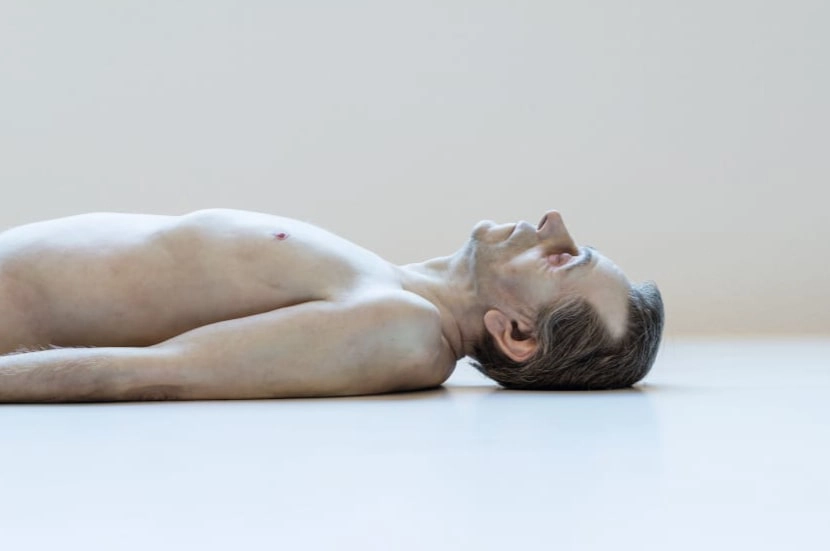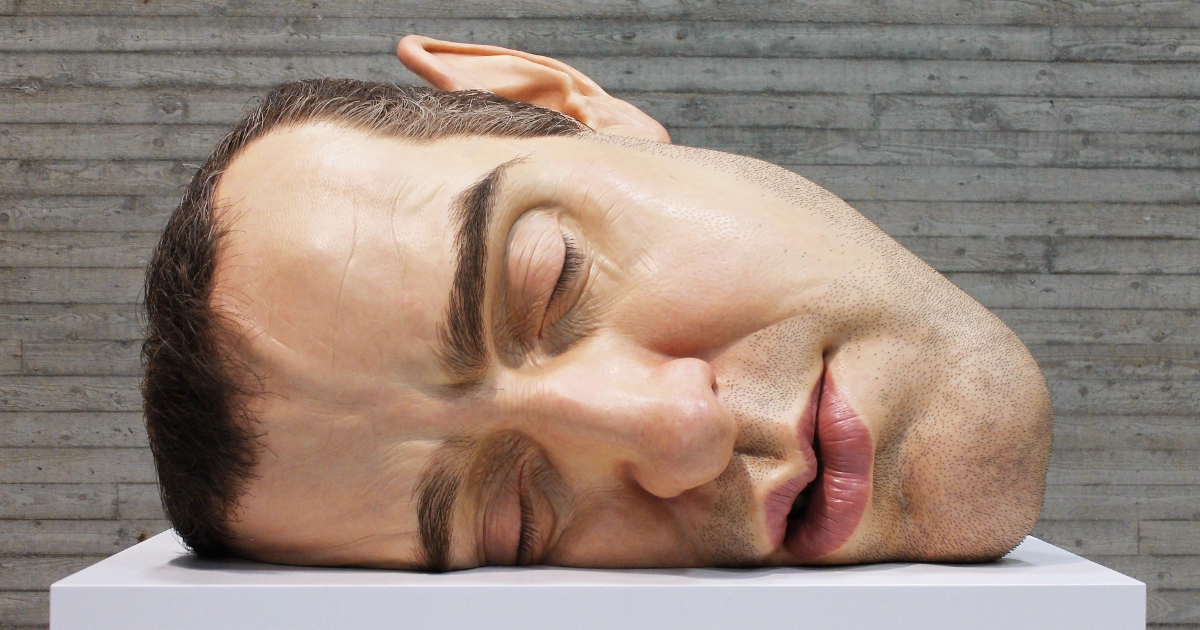I vividly recall my introduction to Ron Mueck, almost as if it happened yesterday. A creative friend enticed me with the promise of an art gallery visit in Paris, and my enthusiasm for anything “art” had me on board immediately. Without a second thought, I put my trust in my friend’s ability to guide me towards something extraordinary and off we went.
I had no clue what kind of work I’d be stepping into. But then—there it was. A massive human head resting quietly on a plinth. A sculpture. Hyperreal, eerily still, and deeply intimate. The sleeping face sagged gently from the invisible pull of gravity, just like ours does when we’re wrapped in bed and letting go. That softness. That vulnerability. It was so subtle, so ordinary, and yet, completely arresting.
From that moment on, I was hooked. I wandered through the rest of the exhibition spellbound, wanting to see how far this artist could stretch the limits of what sculpture could say about being human.
The artist Ron Mueck
Ron Mueck didn’t start in fine art. In fact, his journey began in the world of puppetry and model-making for film and television—children’s shows, to be exact. And strangely enough, that background feels like the perfect origin when you see the quiet expressiveness in his sculptures today. The sensitivity. The silence. The almost uncanny familiarity.
It wasn’t until the mid-90s, after two decades in the entertainment world, that Mueck made the leap to standalone artist. Born in Melbourne in 1958, he took an unusual turn when he married the daughter of renowned painter Paula Rego. It was actually Rego who nudged him into the art world, she asked him to make a model for a painting she was working on based on Pinocchio.
So Mueck sculpted a small figure: just over 80 cm tall, half-naked and looking more embarrassed than enchanted. “Pinocchio” (1996) was delicate, intimate, and real, not the wide-eyed fantasy we knew from the fairy tale. It was a quiet yet powerful debut.
And from there, things got deeper. Much deeper.
Dealing with death
After the death of his father, Mueck did something most of us wouldn’t dream of doing, he sculpted him. Not symbolically, but literally. He used silicone, styrene, polyurethane, and even some of his father’s own hair to recreate his dad’s body in painstaking detail. Wrinkles, skin tones, the way a body looks when life has left it, he captured it all. He titled the piece Dead Dad, and instead of keeping it private, he displayed it to the public.
It’s a jarring, intimate, and deeply human work. And whether you find it beautiful or disturbing, you’ll feel something—and that’s the whole point.

Hyperrealism turned all the way up
Mueck’s artistic genius lies in his ability to capture the minutest details of the human body. His sculptures are the product of a painstaking and time-consuming process, demanding an unwavering focus on the intricacies he observes. This commitment has firmly established him as a maestro in the realm of hyperrealism. Coined terms like “Super-Real” and “Hyper-Real” find a perfect match in artists like Mueck, who relentlessly pursue extreme lifelikeness. Mueck’s quest for perfection is evident as he faithfully reproduces reality exactly as he perceives it. Playing with scale is one of the key psychological tools that Mueck uses in his work. Despite their strikingly realistic appearances, his figures always deviate from the norm, either larger or smaller than life-size. These concepts metamorphose into true masterpieces.
His first solo exhibition took place in London, when he was 40 years old. One of the highlights of the show was “Boy 1999”, a 5 meter high work. Between 2000 and 2002, the National Gallery in London included him in its list of artists and he gained projection to start touring internationally, presenting sculptures such as “Mother and Son”, “Pregnant Woman”, “Man in a Boat” and ” Bandaged Baby”.
Experience what it means to be alive
Ron Mueck is a bit of a mystery man, and this video gives us a sneak peek into his artistic process. No chit-chat, no explanations—just the artist and his craft. You would think an artist would love being part of his own exhibitions to explain themselves and to make the viewers understand what they wanted to say. But not Mueck. You won’t catch him at the openings of his own shows. Why, you ask? Well, he’s all about leaving room for us to weave our own narratives around his artworks. It’s like a puzzle – piece together your interpretation, and let your experiences do the talking.
Ron Mueck’s work is like that unexpected guest at a party – unforgettable. It’s disruptive, showcasing every intricate detail of the human form, leaving you more curious than ever. Suddenly, you’re contemplating your own body in a newfound light. In a world obsessed with body image, you might catch yourself judging the sculptures, only to realize you’re accidentally judging your own reflection! It’s a journey into the essence of our humanity, exposing both our strengths and vulnerabilities that we often prefer to overlook. Mueck’s art unveils the truth about being human, transforming the ordinary into the extraordinary through his captivating hyperrealism.
Where to see
To my knowledge, Mueck doesn’t have an official website (very on brand). But if you’re itching to witness his mind-bending sculptures (and trust me, you should), check here where he exhibits or which museum has his sculptures. He has many masterpieces scattered around the globe. And if you’ve already had the privilege (just like me) of witnessing his art in the flesh (see what I did there?), please share with me your experiences, I’m curious to hear them.


